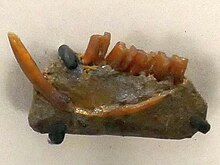Cephalomyidae
Cephalomyidae — вимерла родина кавіоморфних гризунів з Південної Америки. Конкретні стосунки цеї з іншими родинами невизначені.[2]. Скам'янілості родини були знайдені в формаціях Десеадан до Колуеуапіан Фрай Бентос, Десеадо, Серро Бандера та Сарм'єнто, а також у складі Колхуе Хуапі в Аргентині та групі Пука в Болівії[3].
| Cephalomyidae | |
|---|---|

| |
| Нижня щелепа Cephalomys arcidens | |
| Біологічна класифікація | |
| Царство: | Тварини (Animalia) |
| Тип: | Хордові (Chordata) |
| Клада: | Синапсиди (Synapsida) |
| Клас: | Ссавці (Mammalia) |
| Ряд: | Мишоподібні (Rodentia) |
| Інфраряд: | Hystricognathi |
| Парворяд: | Кавієвиді (Caviomorpha) |
| Надродина: | Кавіюваті (Cavioidea) |
| Родина: | †Cephalomyidae Ameghino 1897 |
| Роди | |
Примітки ред.
- ↑ Kramarz, Alejandro Gustavo (2005). A primitive cephalomyid hystricognath rodent from the early Miocene of northern Patagonia, Argentina. Acta Palaeontologica Polonica. 50 (2): 249—258.
- ↑ Rasia, L.L.; Candela, A.M.; Cañón, C. (March 2021). Comprehensive total evidence phylogeny of chinchillids (Rodentia, Caviomorpha): Cheek teeth anatomy and evolution. Journal of Anatomy. 239 (2): 405—423. doi:10.1111/joa.13430.
- ↑ Cephalomyidae at Fossilworks.org
Джерела ред.
- Ameghino, F. 1897. Mammiféres crétacés de l’Argentine (Deuxième contribution à la connaissance de la fauna mammalogique de couches à Pyrotherium) [Cretaceous mammals of Argentina (second contribution to the knowledge of the mammalian fauna of the Pyrotherium Beds)]. Boletin Instituto Geografico Argentino 18(4–9):406–521
- Kramarz, A. G. 2001. Revision of the family Cephalomyidae (Rodentia, Caviomorpha) and new cephalomyids from the early Miocene of Patagonia. Palaeovertebrata 30(1–2):51–88.
- McKenna, Malcolm C., and Bell, Susan K. 1997. Classification of Mammals Above the Species Level. Columbia University Press, New York, 631 pp. ISBN 0-231-11013-8
- Vucetich, M.G., Verzi, D.H., and Hartenberger, J.-L. 2001. Review and analysis of the South American Hystricognathi (Mammalia, Rodentia). Comptes Rendus de l'Académie des Sciences, Série IIA 329(10):763–769.